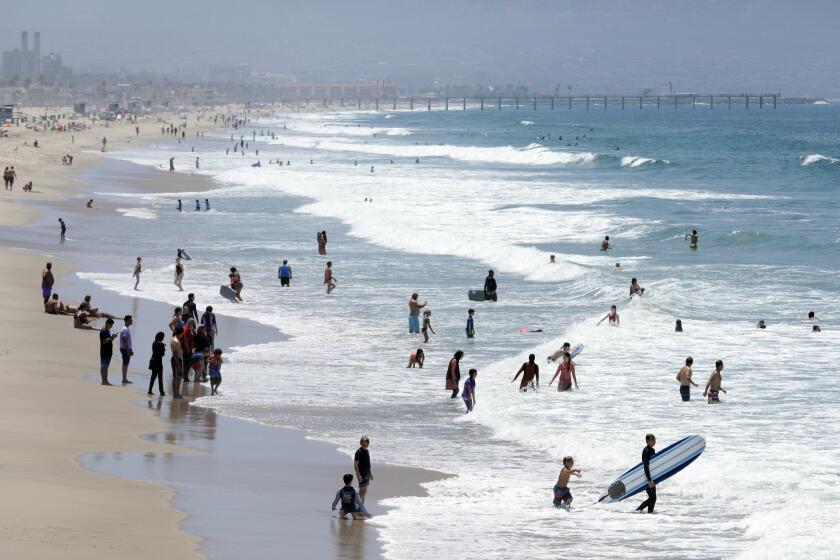Young adults are now the largest group of Americans getting COVID-19, CDC says

- Share via
The longer the COVID-19 pandemic goes on, the younger its victims get.
A new study from the Centers for Disease Control and Prevention reports that the median age of people with COVID-19 in the U.S. has declined over the spring and summer, with Americans in their 20s now accounting for more cases than people in any other age group.
The findings suggest that if the U.S. wants to get its coronavirus outbreak under control, it will need more cooperation from young adults.
In May, the median age of U.S. residents with COVID-19 was 46. By July, it had dropped to 37, then rose slightly to 38 in August.
Likewise, in May, people in their 20s made up 15.5% of confirmed COVID-19 cases nationwide. At the time, they trailed people in their 30s (who accounted for 16.9% of total cases) as well as people in their 40s and 50s (both of those age groups accounted for another 16.4% of cases).
But by June, 20-somethings had taken over the top spot, making up 20.2% of all cases. That figure rose to 23.2% in July, then dropped back to 21% in August.
Gov. Gavin Newsom said Monday said the surge in coronavirus cases hitting California was due in part to younger people who might believe “they are invincible” but nonetheless are becoming sick from COVID-19.
The proportion of cases among Americans in their 30s also increased in June and July. But by August, it had fallen slightly below the level seen in May.
Meanwhile, the share of cases among adults 40 and older decreased steadily through the end of July, according to the study.
The trend toward younger COVID-19 patients came as the total number of new cases increased. In May, 604,570 Americans of all ages were diagnosed with COVID-19. By July, that figure exceeded 1 million — a 71% increase.
The CDC researchers who produced the report drew on three kinds of data: They tallied confirmed cases of COVID-19 in reports from state health departments, examined data from the National Syndromic Surveillance Program to identify patients who went to hospital emergency rooms with COVID-19 symptoms, and analyzed coronavirus test results from 37 states.
The trend toward younger patients was evident in all three data sources, the researchers said.
College reopenings around the country drove a coronavirus surge of about 3,000 new cases a day in the U.S., according to a draft study released this week.
The increase in COVID-19 cases among people in their 20s was striking. In May, 93,741 Americans between the ages of 20 and 29 were newly diagnosed with the disease. That figure swelled to 149,761 in June, 240,105 in July and 189,366 in August.
Americans in their 30s made up the second-largest group of new COVID-19 cases. Among people ages 30 to 39, 101,917 cases were confirmed in May, 130,415 were identified in June, 183,487 were diagnosed in July, and 148,500 were added in August.
Over time, these infections in younger adults appeared to spread to older, more vulnerable adults in certain parts of the country, the researchers wrote.
In the Southeastern U.S., an increase in the test positivity rate for people in their 20s and 30s was followed nine days later by an increase in the positivity rate for people in their 40s and 50s. Six days after that, people ages 60 and up had a higher positivity rate as well.
In the Southwestern U.S., an increase in the positivity rate for people under 60 was followed about four days later by an increase in the positivity rate for people ages 60 and up. The same pattern was seen in the south-central states, though the lag there was seven days.
This sequence of events offers “preliminary evidence that younger adults contributed to community transmission of COVID-19 to older adults,” the researchers wrote. “Similar observations have been reported by the World Health Organization,” they added.
The more people see wearing face masks and practicing social distancing as ways to protect the health of others, the more likely they are to comply, research shows.
There are several plausible explanations for why this might be the case, the CDC team wrote. Younger adults are more likely to work in restaurants, stores, childcare centers and other places that put them at greater risk of exposure to the coronavirus. At the same time, they may be more cavalier about social gatherings and more lax about the need for physical distancing.
Also, the fact that younger adults are more likely to have mild COVID-19 symptoms or even asymptomatic infections means they’re more apt to spread the virus without even realizing they’re sick.
The median age of people with positive coronavirus test results began falling before there was a drop in the median age of all people who got tested. That essentially rules out the possibility that the observed drop in patients’ ages can be chalked up to more testing by younger people, the CDC team wrote.
The findings underscore the need for health officials to target younger adults with “age-appropriate prevention messages” about the importance of preventing COVID-19 spread, the study authors wrote. (Paul Rudd, are you listening?)
The study was published Wednesday in the CDC’s Morbidity and Mortality Weekly Report.










